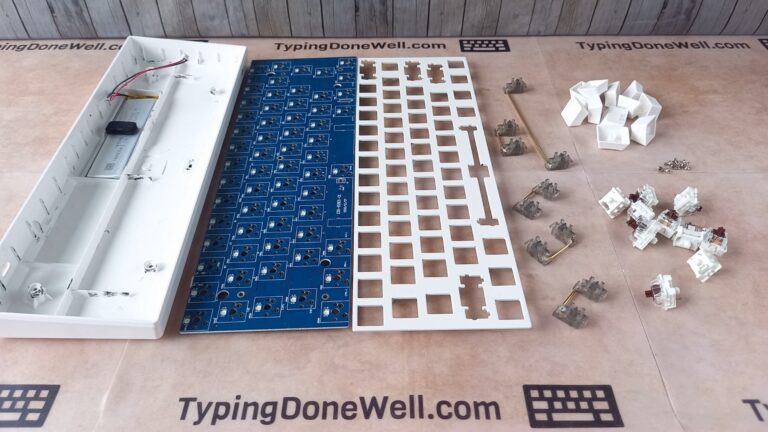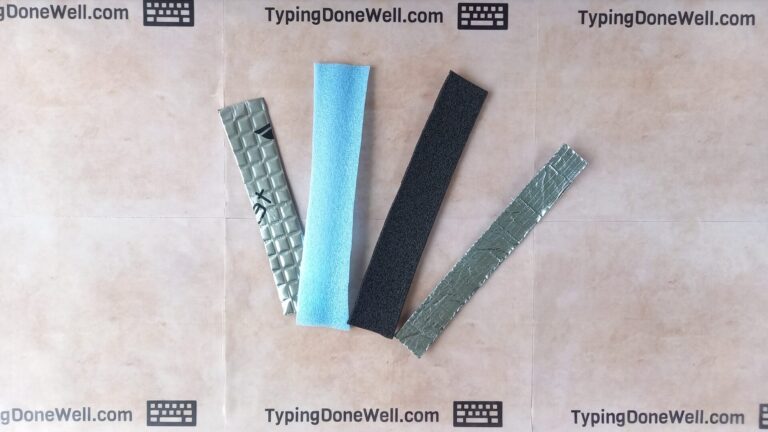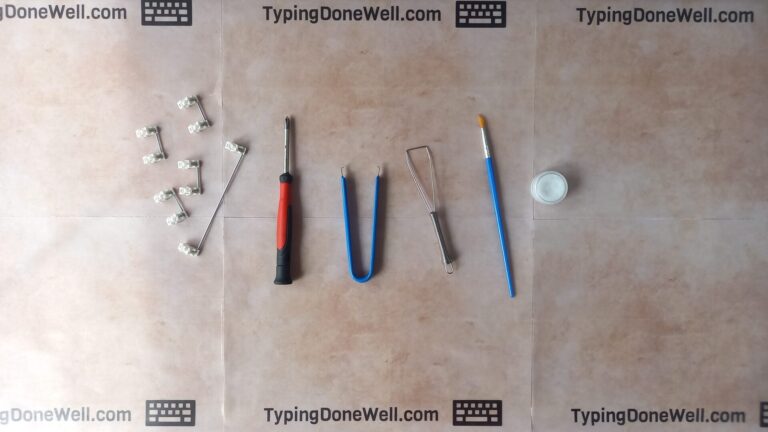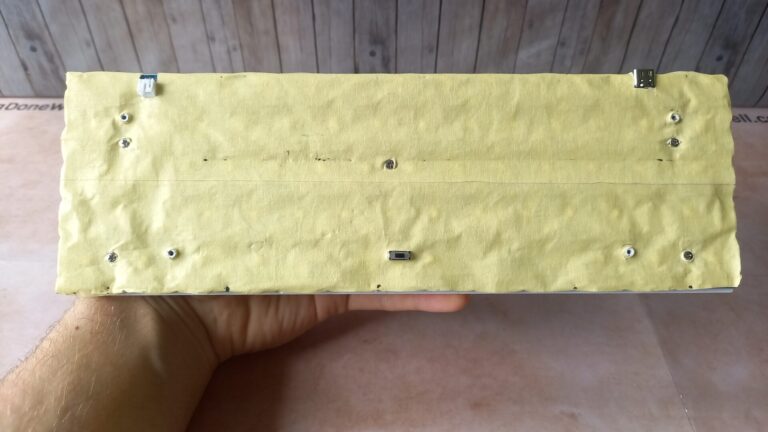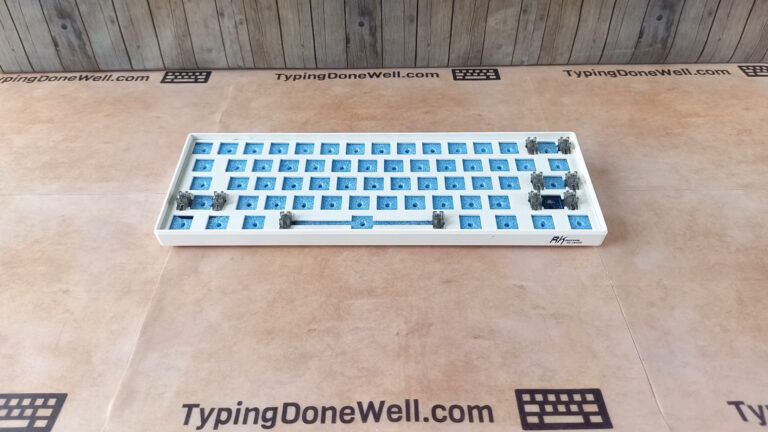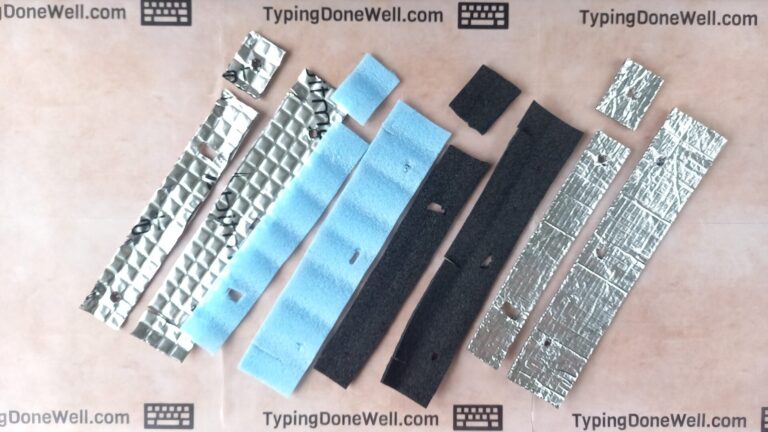How to lube mechanical switches? – beginner’s guide (with detailed videos)
Switches – they are part of a mechanical keyboard that we focus most of our attention on. Although, to make a great keyboard build you need to take care of many more things. The smallest details that stack together make a huge difference in the end result.
However, if you were to ask me for one mod that will make the biggest impact on the typing experience I would say – switches. There is a good reason why people focus so much on those little things when modding a keyboard.
It can be quite overwhelming, to be honest. You need to choose the right switch, then you need to remove keycaps from your keyboard, then remove switches, lube the new (or old) switches, and finally piece everything back together.
Today I will walk you through a step-by-step process of lubing a keyboard switch. I won’t talk about removing keycaps and switches from a keyboard.
If you don’t know how to remove keycaps or switches I recommend you check out my article. It will give you everything you need to remove both keycaps and switches from your keyboard – ARTICLE DISASSEMBLE KEYBOARD
Lubing after desoldering switches from a keyboard or without this step on a soldered PCB keyboard is a bit more tricky. But that’s a topic for a whole other discussion.
What tools do you need to lube a switch?
| Switch opener | You will need a switch opener in order to open the switch before lubing it. You could try opening switches with tweezers but it’s extremely cumbersome. Here’s a cool-looking switch opener – BUY A SWITCH OPENER |
| Stem holder | This tool is pretty much essential. Without a stem holder lubing switches is way more difficult. Here’s a link where you can buy one – BUY A STEM HOLDER |
| Small brushes (one for every 25 switches) | With brushes, it’s better to buy a few of them. I’ll give you a link to a handy pack of 3 nylon brushes. This should last you a lubing session for a whole keyboard – BUY BRUSHES |
| Lube | Here you can buy Krytox 205g0 (which is a perfect lube to start with) – BUY KRYTOX LUBE |
| + Tweezers | You will need proper tweezers. They will make the lubing process easier. Still, you can lube your switches without them. |
To lube a switch you will need a switch opener, a stem holder, a small brush, tweezers, and lube (preferably Krytox 205g0).

You might be able to lube one switch without a stem holder and a switch opener but it would be extremely cumbersome. I recommend you get all of those listed tools – it will make your life way easier.
Do you need to lube keyboard switches?
Lubing is a complicated process that requires spending a lot of time in order to do it. You also need special tools if you want to lube your switches. Is there really a reason to do something like that? What’s the benefit of lubing keyboard switches?
Lubing switches makes a huge difference in both the feel and sound of the switch when typing. It will make it feel smoother and better to type on. Lubing a switch will also quiet it down and remove unpleasant sounds like spring ping or mid-travel sound distortions.
Overall, lubing makes a huge difference in the feel when typing and in the sound of the switch. This practice can make your keyboard sound way more expensive and professional while saving you a bit of money.
I didn’t only want to tell you this. I also want to show you the real difference between an unlubed switch and the one that I’ve lubed. I hope that you’ll be able to see the difference on camera:
I recorded the audio with an external mic to make it a bit better to see on the recording. Honestly, lubing makes a huge difference and in the end, it’s worth all the trouble that you have to go through.
This mod also changes the feel of the switches. There’s no real way to show it, it’s even challenging to describe but I’ll try it anyways.
When pressing down a stock switch you can often feel an unwanted resistance. I’m not talking about the one from the spring. Something like resistance in the middle of key travel that’s caused by friction inside the switch. Lubing gets rid of that making the switch feel smooth.
Do switches come pre-lubed from the factory?
You might be thinking – what’s the point of lubing a keyboard switch if they come already lubed from a factory? At least they should, right?
Most switches aren’t lubed from the factory. In order to buy switches that are pre-lubed you need to get the ones that are „factory-lubed”. You also need to ensure that said factory lubing is a high-quality process.
Unfortunately, most switches aren’t lubed from the get-go. In my opinion, they should. The good news is that many companies are starting to make switches that they lube. Those are a bit more expensive but the amount of your time that it can save is worth it.
However, the quality of this factory lubing practice is dependent on the manufacturer. There are companies that do it quite well while others are very inconsistent.
I advise you to lube the switches for your first keyboard. You will learn a lot while doing so. Secondly, you will have switches that are of higher quality for a more affordable price. And lastly, I hope you’ll have fun lubing the switches.
What should you use to lube your switches?
I see many people on the internet get into this whole debate on what lube you should use. Before they even start lubing the switches they spend a lot of their time debating on the „perfect lube for switches”.
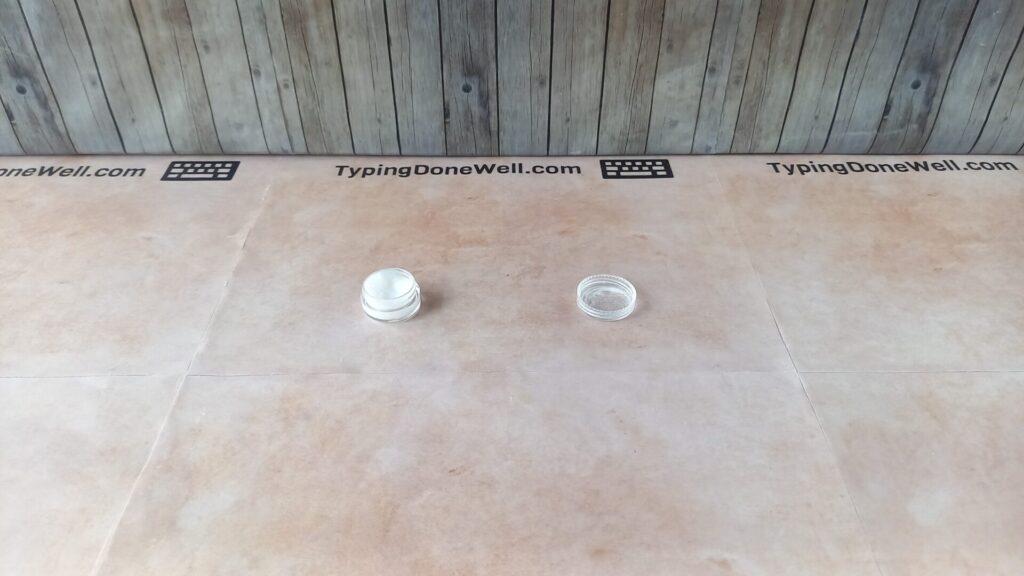
Let me tell you something from my experience – it doesn’t matter. It’s just lube for switches, why overthink it so much?
The best idea is to get Krytox 205g0 to lube your switches. This is a reliable lube that will work for every switch type. But if you can’t get this particular product simply choose another one that’s designed for keyboards, no need to overthink it.
Yes, I have to admit – not all the keyboard lubes out there are the same. Yes, they perform a bit differently. But honestly, it’s way more important to have a good lubing technique than to use Krytox over G-lube.
Just pick one switch lube that you can easily get your hands on and start lubing your switches. It’s not rocket science.
How much time do you need to lube switches?
Lubing switches is a time-consuming process. Especially if you want to lube a whole keyboard’s worth of switches for your build. This can scale up pretty quickly, so you need to be ready for it.
On average it takes 2.5 minutes to lube one switch if you know what you’re doing. This speed can even go up a bit – when focusing you can lube around one switch every 2 minutes. This means that you will lube around 25 switches every hour.
That’s what I’ve found out when lubing switches myself. For the purpose of this article, I measured how much time it takes me to lube switches.
When doing it casually I managed to finish 10 switches in 25 minutes which gives an average of 2.5 minutes per switch. Then I did a test while focusing on the lubing process – no distractions, only some music in the background. I lubed 21 switches in 42 minutes that way.
All of that was done without using the spring bad lubing method and without any switch lubing station. Only the tools that I’ve listed are at the top of this article. And, of course, a bit of experience of my own.
How to open a keyboard switch?
That’s enough of the things that you need to know before even starting. At this point, you should be ready to start lubing the switches.
First, I will show you how to properly open a switch. This is something that you will do for every single switch so it’s important to learn it well. It’s not complicated once you know how things work.
To open a switch you first need to align it properly. Place the top of the switch (often a small hole) aligned with the top of a switch opener. Then gently press the switch down and take it out of the tool.
It can be a bit tricky to know where the top of the switch and the top of a switch opener is. It will be easier to see in the video that I took for you:
You can see a small hole at the top of a switch – that’s an indication that we are looking for. It will be useful during the actual lubing process.
When it comes to the switch opener the „spikes” (or wedges in a different type) need to be pointing to the middle from both sides.
How to lube keyboard switches?
Of course, before even starting you need to get the switches out of the keyboard. If you bought new ones to replace them on your keyboard completely or you’re building a keyboard from scratch, you can skip this.
Then you will need to take the switches out of the PCB (out of the keyboard). I also have a detailed article that will guide you through all the required steps – ARTICLE DISASSEMBLE KEYBOARD
Finally, now you should have a bunch of switches ready to be lubed.
I will show you how to lube each part of the switch individually, just to make it easier to understand. Then I will show you the whole process in one, continuous take.
How to lube the switch’s bottom housing?
The first part of the switch that I will show you is the bottom housing. Here the most important thing for you to pay attention to is the difference in lubing linear vs tactile or clicky switches.
First, let’s talk about a part of the bottom housing that’s lubed universally across pretty much all switch types – when lubing bottom housing you need to lube slider rails.
In order to lube the switch’s bottom housing first get a tiny amount of lube on your brush. Then place half of it on one slider rail and the rest on the other. Finally, brush the lube until you can’t see it. If you are able to see the lube it means that you’ve put in too much.
Then what I like to do is put the rest of the lube into the center mast (the hole in the middle). Then you can lube the metal leaf but only if you’re lubing a linear switch. Doing this on tactile or clicky would cause them to lose their properties.
Here’s how you should lube the bottom housing of a tactile or clicky switch:
Remember to stay away from the metal leaf when you are lubing tactile or clicky switches.
When you want to lube a linear switch you can lube the metal leaf. I actually recommend that you do. It’s a good practice that ensures your linear switch is smooth all the way down. Here’s how you should lube a linear switch’s bottom housing:
And that’s the bottom housing done. How you can put it down somewhere and move on to the next part of the switch.
How to lube the switch’s spring?
Lubing a spring is very simple and universal for all switch types. What’s more, you don’t need to worry about overlubing it. This part of a switch is very forgiving. Still, it’s worth lubing the spring in order to remove any possible noises.
In order to lube a switch’s spring you need to take it and place a fairly small amount of lube on both ends. Then brush the lube into those ends of the spring until you can’t see it anymore.
Here’s how it should look like on a video that I took for you:
Then you simply place it in the bottom housing. I will show you how to do that in the end on a video with a whole process of lubing the switch.
There’s one more thing that I want to tell you about. There’s a method of lubing multiple springs at once in a bag. There are no contraindications to doing that. However, I never found it faster.
For me, it’s easier and more effective to lube one switch after another. But once you get better at lubing you could try this method, maybe it will fit you.
How to lube the switch’s stem?
The switch’s stem is the part that creates the most friction when typing. That’s why it’s important to lube it properly. It will also determine how the switch will feel when pressed.
When lubing the switch’s stem make sure to hold it in a stem holder. Then brush a miniature amount of lube on both sides with stem rails. Then you can lube the backside but make sure to lube the stem legs only for linear switches.
Once again, lubing the stem legs can cause tactile and clicky switches to lose their properties and turn to pretty-much-linears. Make sure to be careful when lubing this part and use as little lube as you can.
Here’s how to do this for tactile and clicky switches:
Now, for linear it’s a good practice to lube the stem legs. It’s very similar to the metal leaf in the bottom housing. In fact, those parts will work together and activate the switch when pressed against each other.
Here’s a video that I’ve made to show you how to lube the stem for linear switches:
Then all you need to do is take this stem out of the stem holder. This can be a bit tricky but I will show you a good trick in the video that shows the whole process.
How to lube the switch’s top housing?
The last part that we have left to lube is the top housing. Many people skip this part. I like to give it just a bit of attention. It will improve the way your switch works by only the slightest amount. But you know what they say: the devil’s in the details.
The switch’s top housing only needs the slightest amount of lube. Place it on both sides from the inside where the stem touches it. Then spread it evenly in a small radius.
This might be a bit hard to understand from this description. I hope the video will help you picture the proper way to lube the top housing:
After doing that you can piece the switch back together. Just remember not to do this inside the switch opener 🙂
How to lube a mechanical keyboard’s switch?
Now it’s time to join everything together and show you the whole process. So let’s recap everything here:
In order to lube a mechanical switch you need to open it first using a switch opener. Then you need to lube the bottom housing, spring, stem, and top housing with the right technique. Make sure to adjust it for the switch type. Finally, put everything back together and close the switch.
Now I will finally show you the video of the whole process in one cut. Look carefully, there are some tricks there to make the lubing process better:
That’s how you lube a tactile or clicky switch. Now let’s move on to the linear type. There’s the whole process for it:
In reality, this process doesn’t take as long as in the video. I had to make sure that it was pretty good to see what I’m doing there. Once you start lubing switches yourself you’ll develop your own, slightly different method. And it will definitely be faster than my speed while recording.
One more thing. I can’t emphasize this enough – use only a slight amount of lube. If you overlube a switch it will feel bad to use it. And let me tell you, it’s way harder to remove the lube from a switch than it is to add just a bit more.
What happens if you overlube switches?
I said it multiple times throughout this article – use a slight amount of lube. „Why is that?” – you might ask. Is it not that the more lube you put in the switch the better?
In fact, no. Putting too much lube can result in overlubing your switches. And this brings unpleasant consequences that are pretty hard to undo.
Overlubed switches become mushy and feel unresponsive. There shouldn’t be any damage on such a switch but the feeling when typing will be way worse. A mechanical switch can feel like a membrane switch when typing or lose its other characteristics.
An overlubed clicky or tactile switch will lose the properties that make it this switch type. There will be pretty much no tactile bump or click in an overlubed tactile or clicky switch.

Linear switches are a bit more forgiving as they are completely smooth in their travel by design. However, even those can in extreme cases feel more like a membrane switch than a linear one.
Can you open a switch without a switch opener?
Some people are wondering if there’s a point in buying a switch opener. Let me tell you that opening multiple switches without one is extremely cumbersome. I would recommend buying a switch opener even if you need it only for 5 switches.
It is possible to open a switch without a switch opener. You can do this with tweezers alone. However, it is extremely cumbersome, and opening multiple switches that way isn’t worth the money that you could save.
Trust me, get yourself a good switch opener. Even more, I will give you a direct link to where you can buy such a tool. It will save you a lot of time and struggle – BUY A SWITCH OPENER
Do you need a syringe to lube hot-swap switches?
You might have heard that you need a syringe to lube switches. This might be true for some tricks to lube soldered switches without desoldering them from the PCB.
There is no need for a syringe to lube hot-swap switches. All you need for that is a switch opener, stem holder, small brush, tweezers, and lube (plus a keycap puller and switch puller if you need to take the switches out of the keyboard first).
And even on the keyboard that’s not hot-swappable you can still lube switches without a syringe. You just need to desolder them first from the PCB.
How often do you need to lube keyboard switches?
Is there a need to lube switches once a month, or maybe once a year? If so, how often do you need to lube switches in order to keep them at their peak performance?
Most of the time there is no need to relube your switches. Especially when using a thick switch lube like Krytox 205g0. It would take years for this lube to run out. You are far more likely to damage the keyboard at this point.
You probably won’t ever need to relube your switches. The only reason to do so would be if you didn’t lube them properly. In most cases, switches don’t run out of lube like Krytox 205g0 for years.
However, if you feel like your switches aren’t performing as well you can always lube them again. Maybe you missed a few spots when lubing for the first time? It happens sometimes.
That’s the end of this article. I hope that you found it helpful, especially if you’re just getting into this hobby. Modding keyboards is pretty fun and I hope you’ll feel that way about it.
At the end I want to remind you of two things – beware of the switch type that you are lubing and use only a slight amount of lube. With that said, I wish you a great session of modding your keyboard switches!

